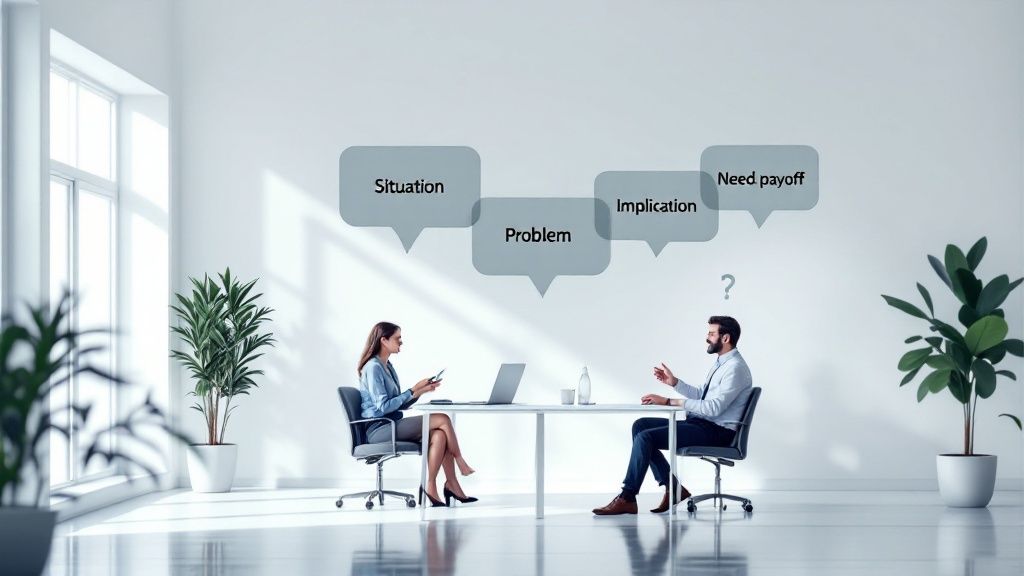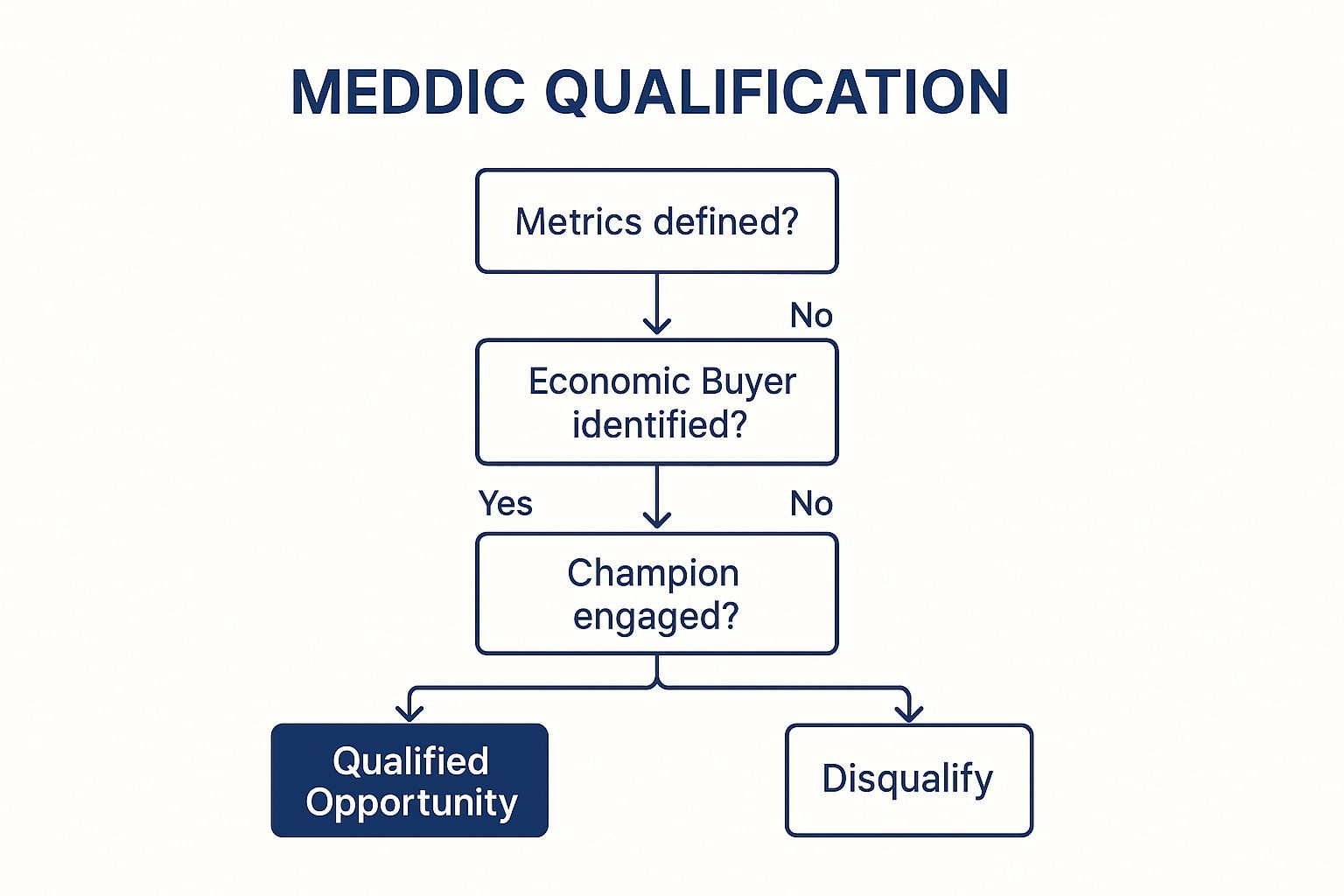A Guide to AI Prospecting Tools
Discover the best AI prospecting tools to automate lead generation, personalize outreach, and close more deals. A guide for modern sales teams.
Discover the top 10 sales training methodologies for 2025. This deep dive covers everything from Challenger to MEDDIC to help you close more deals.
The B2B sales landscape is more complex than ever. Buyers have more information, competitors are more sophisticated, and generic pitches get deleted instantly. To succeed, your sales team needs a structured, repeatable approach—a methodology that aligns with how customers actually buy.
But with so many frameworks floating around—SPIN, MEDDIC, Challenger—where do you start? Choosing the wrong one leads to wasted effort and missed quotas. The right one provides a clear path to predictable revenue. This guide cuts through the noise, breaking down 10 of the most effective sales training methodologies. We’ll give you a clear, actionable roadmap to choose and implement the right framework for your team.
We’ll explore what makes each one work, who it's best for, and how to put it into practice. To elevate your approach, consider using proven video strategies for sales to make your outreach stand out. Let’s dive in and find the methodology that will redefine your team's success.
Pioneered by Matthew Dixon and Brent Adamson, The Challenger Sale argues that the most successful reps win by teaching, tailoring, and taking control of the conversation. It disrupts the old belief that success is built solely on relationships.

The methodology is based on a massive study that identified five sales profiles. In complex B2B sales, "Challengers" consistently outperform the others. They aren't afraid to push a customer's thinking and introduce them to new perspectives or solutions they hadn't considered.
This approach isn't about being aggressive; it's about being assertive with valuable insights. The core is "Commercial Teaching," where reps teach prospects something new and valuable about their own business, which compellingly leads back to the seller's unique solution.
Key Insight: The Challenger model thrives when the status quo is your biggest competitor. By teaching prospects about a problem they didn't know they had, you create urgency and differentiate your solution from the start.
This methodology is particularly effective for organizations selling complex, disruptive, or high-value solutions. Companies like Xerox have reported significant increases in win rates after implementing it. If your goal is to break through a noisy market and become a trusted advisor, the Challenger framework is a powerful tool.
Developed by Neil Rackham, SPIN Selling is a foundational sales training methodology that transformed complex sales by shifting the focus from pitching to questioning. It’s built on research analyzing over 35,000 sales calls. The core principle is that in large sales, customers buy to solve problems, and the salesperson’s role is to guide them to this realization through a specific questioning sequence.

Unlike traditional methods that push product features, SPIN Selling pulls the customer toward the solution. It empowers reps to uncover deep-seated needs and build a powerful value case collaboratively with the buyer. This approach is less about persuasion and more about skillful consultation.
SPIN is an acronym for the four stages of questioning that guide the sales conversation, moving from a general understanding to a powerful vision of a solution. The sequence is designed to build a solid foundation of need before a solution is ever presented.
Key Insight: The magic of SPIN Selling lies in the Implication and Need-Payoff questions. By helping the customer connect their problems to business consequences and then envision the value of solving them, you get the customer to sell the solution to themselves.
This methodology excels in environments where trust and understanding are paramount, like high-value software or professional services. If your sales cycle is long and requires buy-in from multiple stakeholders, SPIN provides a reliable framework for building value.
Popularized by Michael Bosworth, Solution Selling is a classic sales methodology that fundamentally shifts the focus from products to problems. Instead of leading with features, sales professionals act like consultants, diagnosing a prospect's challenges and then prescribing their product as the ideal solution. It’s about selling outcomes, not just items.

This problem-led approach excels because it aligns the seller directly with the buyer's needs, building trust and demonstrating value from the first interaction. Rather than pushing a product, the rep guides the customer on a journey to uncover and articulate their "pain points."
The core of this methodology is a diagnostic process. Reps use skillful questioning to understand the root cause of a prospect's business issues, the impact of those issues, and the vision for a better future. This makes the sales conversation highly relevant to the buyer.
Key Insight: Solution Selling transforms the sales rep from a vendor into a valued problem-solver. When a buyer feels you understand their problem better than they do, price becomes secondary to the value of the solution.
This methodology is highly effective for companies selling customizable or complex services and software. It's a foundational skill for any B2B sales professional aiming to build long-term, value-based relationships.
Developed by David Sandler, the Sandler Selling System flips the traditional sales process on its head. Instead of chasing prospects and aggressively pushing solutions, this methodology emphasizes mutual qualification and honest communication. It operates on the principle that the seller should be a trusted advisor who helps the buyer discover their own needs.
The system is built around a "Submarine" model, where each step of the sales process must be sealed before moving to the next. This systematic approach, rooted in psychology, empowers the salesperson to control the process, not the prospect. It focuses heavily on qualifying prospects early, ensuring time is spent only on deals that have a real chance of closing.
This approach creates an equal footing between buyer and seller through a structured process. The core tenets are establishing trust, uncovering the prospect’s true "pain," and agreeing on the terms of the engagement before any solution is presented. This avoids wasting time on proposals for unqualified leads.
Key Insight: The Sandler System teaches that you should be as willing to disqualify a prospect as you are to qualify them. By focusing on mutual fit, you transform the sales dynamic from a pitch into a collaborative problem-solving session.
This is one of the most enduring sales training methodologies because it protects the salesperson's time and builds authentic relationships. It is highly effective in professional services, financial advising, and complex technology sales where trust is paramount.
Developed at software company PTC, the MEDDIC Sales Process is a rigorous B2B qualification framework. It’s less of a conversational methodology and more of a checklist-driven process to ensure sales teams pursue winnable, high-value deals. MEDDIC provides a systematic way to gather critical information, helping teams forecast with precision.
The acronym stands for Metrics, Economic Buyer, Decision Criteria, Decision Process, Identify Pain, and Champion. By systematically checking each of these boxes, reps build a comprehensive understanding of an opportunity. It’s particularly dominant in the enterprise SaaS and technology sectors.
MEDDIC operates as a qualification blueprint. Reps use the framework to guide discovery calls and strategic planning, ensuring they have verifiable answers to the most important questions before committing resources to a deal.
Key Insight: MEDDIC forces an objective, evidence-based approach to sales. If you can't confidently check off each letter in the acronym with specific, verified information, the opportunity is not truly qualified.
This infographic illustrates a simplified decision flow using core MEDDIC principles to quickly assess opportunity viability.

The visualization highlights how a "No" at any critical stage, such as failing to identify the economic buyer, should prompt a re-evaluation of the deal. Companies like Salesforce and HubSpot use elements of MEDDIC to bring discipline to their sales pipelines.
Consultative Selling transforms the salesperson from a product pusher into a trusted advisor. This methodology shifts the focus from pitching products to diagnosing a customer's problems and co-creating a solution. It prioritizes long-term relationships and value creation over transactional wins.
The core principle is that today's buyers don't need a walking brochure. They need an expert who can help them navigate complexity, understand their challenges, and achieve their business objectives. The consultative seller acts as a guide, using deep listening and strategic questioning to uncover needs.
This approach is built on empathy, credibility, and expertise. Instead of leading with a presentation, the salesperson leads with questions designed to explore the customer's world, their pain points, and their desired future state. The entire process is collaborative.
Key Insight: Consultative Selling excels where trust is paramount and the solution isn't a simple commodity. It positions the salesperson as a strategic partner, making price secondary to the value and expertise being delivered.
This is one of the most versatile sales training methodologies, effective for companies that require a deep understanding of their clients' operations. If your goal is to be seen as an indispensable resource rather than just another vendor, adopting a consultative mindset is essential.
Value-Based Selling shifts the conversation away from features and price, focusing instead on tangible, quantifiable business outcomes. This methodology positions sellers as strategic partners who solve core business problems, justifying the investment through demonstrated ROI. Instead of leading with what you sell, you lead with why it matters to the customer's bottom line.
This approach is rooted in the idea that customers don't buy products; they buy better business results. It requires a deep understanding of the customer's operational challenges and financial goals. Reps must be able to articulate precisely how their solution will generate revenue, reduce costs, or mitigate risk.
The core of this methodology is translating product capabilities into financial impact. It moves the sale from a simple purchase to a strategic business decision. The process involves in-depth discovery to uncover pains that can be monetized.
Key Insight: In Value-Based Selling, the competition isn't another vendor; it's the customer's decision to do nothing. By proving that the cost of inaction is greater than the cost of your solution, you create a powerful incentive to buy.
This is one of the most effective sales training methodologies for enterprise B2B sales, where purchase decisions are scrutinized by multiple stakeholders. Companies like Salesforce and SAP excel at this by demonstrating how their platforms directly impact KPIs.
Developed by IBM, BANT is one of the most foundational lead qualification frameworks in sales. It provides a simple checklist for reps to quickly assess whether a prospect is a good fit. The goal is to avoid wasting time on leads that are unlikely to convert.
The acronym stands for Budget, Authority, Need, and Timeline. By asking targeted questions to uncover information about these four key areas, reps can prioritize high-potential opportunities. It is a classic among sales training methodologies because of its straightforward and effective approach.
The BANT framework guides reps to qualify leads by systematically confirming four critical buying signals. It’s less about a rigid script and more about ensuring these crucial data points are gathered early.
Key Insight: BANT is most effective as a quick-filter mechanism, especially for high-volume inside sales teams. It helps reps efficiently separate promising leads from those that are a poor fit, optimizing the sales funnel.
This methodology is ideal for organizations with a transactional or less complex sales cycle. Many technology companies incorporate BANT scoring into their lead management systems. While it can be too rigid for highly complex sales, it remains a powerful starting point for any qualification conversation.
Popularized by Keenan, The Gap Selling Methodology is a problem-centric framework that shifts the focus from the product to the prospect's pain. It operates on a simple principle: sales happen when a buyer recognizes a significant gap between their current situation and their desired future state. The salesperson’s job is to uncover, define, and quantify that gap.
This methodology forces a deep understanding of the customer's business reality before any pitch is made. Instead of leading with features, reps act as diagnosticians, helping prospects see the tangible impact of their problems. It’s an approach built on diagnosis, not demonstration.
Gap Selling is a structured process of discovery and problem-solving. Sales reps guide prospects to articulate their own challenges and desired business outcomes, creating intrinsic motivation to change. This is achieved by meticulously uncovering the root cause of their issues.
Key Insight: Gap Selling flips the traditional sales script. Instead of selling a product, you are selling the business outcome a prospect desires. The urgency to buy comes from the prospect’s own understanding of the cost of inaction.
This methodology is highly effective for organizations where the solution directly solves a measurable business problem, such as SaaS companies improving productivity or professional services firms streamlining operations.
In a digital world, Social Selling has emerged as a crucial methodology. It moves beyond cold calling, instead leveraging social media platforms to find, connect with, engage, and nurture prospects. The core principle is to build authentic relationships and establish credibility by providing value long before making a sales pitch.
This approach transforms reps from intrusive sellers into trusted advisors. By participating in relevant online conversations and sharing valuable content, sales professionals build rapport and gain insights into their prospects' needs. This methodology is particularly powerful in B2B environments where platforms like LinkedIn are central to professional networking.
Effective Social Selling is a marathon, not a sprint. It’s about consistently building a professional brand and a network. Success comes from strategic, value-driven interaction rather than direct, unsolicited sales messages.
Key Insight: Social Selling is about warming up the "cold call." By establishing a connection and providing value upfront on platforms where your prospects are active, you dramatically increase the likelihood of a positive response when you initiate a direct conversation.
This is one of the most adaptable sales training methodologies, valuable for nearly any industry. To master it, complement this methodology with actionable social media marketing strategies to effectively engage prospects online. By building a strong personal brand, you create an inbound funnel of opportunities.
| Sales Methodology | Implementation Complexity | Resource Requirements | Expected Outcomes | Ideal Use Cases | Key Advantages |
|---|---|---|---|---|---|
| The Challenger Sale | Moderate to high; requires mindset shift and training | Needs skilled trainers and insight development | Higher win rates, customer trust, competitive differentiation | Complex B2B sales, enterprise solutions, consultative selling | Drives performance with insight-led selling and control of conversation |
| SPIN Selling | Moderate; mastering questioning flow takes practice | Training on question techniques and customer research | Reduced buyer resistance, uncover hidden needs | Complex sales, B2B, consultative and high-value sales | Builds consultative conversations through strategic questioning |
| Solution Selling | Moderate; requires deep industry and product knowledge | Diagnostic tools and expertise development | Higher close rates, strong customer relationships | Complex B2B, custom solutions, consulting services | Focuses on problem-solving and value proposition |
| Sandler Selling System | Moderate to high; requires significant training | Training investment, psychological skill development | Better prospect qualification, honest buyer relationships | Relationship-based sales, professional & financial services | Emphasizes mutual qualification and upfront contracts |
| MEDDIC Sales Process | High; systematic and disciplined application needed | Continuous coaching and discipline | Improved forecast accuracy, focused pipeline | Complex B2B, enterprise software, long sales cycles | Clear qualification framework with measurable business impact |
| Consultative Selling | High; needs deep expertise and long-term investment | Knowledge development, ongoing training | Strong long-term relationships, increased customer trust | Professional services, complex B2B, high-value transactions | Builds advisor role and long-term value creation |
| Value-Based Selling | Moderate to high; requires analytical capabilities | ROI tools, financial data access, expertise | Premium pricing, stronger business justification | Enterprise sales, B2B technology, high-value deals | Quantifies business outcomes and reduces price competition |
| BANT Qualification | Low; simple and easy to implement | Minimal training, straightforward process | Faster lead prioritization and qualification | Lead qualification, inside sales, transactional sales | Simple, standardized framework for quick lead assessment |
| The Gap Selling Methodology | Moderate; requires strong discovery skills | Training in gap analysis and solution positioning | Clear value propositions, customer urgency | Problem-focused sales, consultative B2B, solution industries | Creates urgency by defining current vs future state gap |
| Social Selling | Moderate; time-intensive to build presence | Content creation, social media management | Enhanced credibility, warm outreach, buyer insights | B2B sales, professional services, technology sales | Leverages digital platforms for relationship building and thought leadership |
We've explored ten distinct sales training methodologies, from the disruptive approach of The Challenger Sale to the precise qualification of MEDDIC. The journey reveals a crucial truth: there is no single "best" methodology. The optimal choice is a strategic decision tailored to your unique sales environment.
Effective sales leaders know that selecting a methodology is just the first step. True mastery comes from commitment, integration, and continuous reinforcement. Simply handing your team a playbook for SPIN Selling isn't enough. The goal is to embed the principles into your team's DNA, making it the default language for deal reviews and customer interactions.
The real power often lies in creating a hybrid model that works for you. A transactional sales team might lean on BANT for quick qualification while using Social Selling to build a pipeline. An enterprise team might build their process around MEDDIC while using Challenger principles to reframe customer perspectives in key meetings.
Consider these practical combinations:
The common thread through all successful sales training methodologies is the shift from product-centric pitching to customer-centric problem-solving. It's about transforming your sales team from vendors into trusted advisors who guide buyers through complex decisions.
Adopting a new framework without the right tools is like navigating a new city without a map. Modern sales is too complex to rely on intuition alone. This is where technology, specifically AI-powered account intelligence, becomes a non-negotiable part of a successful implementation.
Imagine empowering your team with real-time insights that bring your chosen methodology to life. Instead of guessing a prospect's pain points for a Sandler-based discovery call, your reps are armed with AI-surfaced data on company challenges. When preparing for a Challenger sale, they have access to industry benchmarks and disruption triggers specific to that account. This technology transforms abstract theory into a concrete, actionable advantage.
Ultimately, the path from methodology to mastery is a journey of strategic selection, deep integration, and technological empowerment. It requires leadership buy-in, consistent coaching, and a commitment to learning. By choosing the right framework and equipping your team with the intelligence to execute it effectively, you build a predictable, scalable revenue engine.
Ready to move from theory to action? Salesmotion is the account intelligence platform that activates your chosen sales methodology with AI-driven insights, helping your team identify buyer intent, understand customer pain points, and execute every play with precision. See how to empower your framework at Salesmotion.
Discover the best AI prospecting tools to automate lead generation, personalize outreach, and close more deals. A guide for modern sales teams.
See how Salesmotion stacks up against Demandbase, what the differences of the two platforms are and which is best for your use case.
A practical guide to designing a sales rep territory plan that boosts morale and revenue. Learn data-driven strategies for balanced and effective...